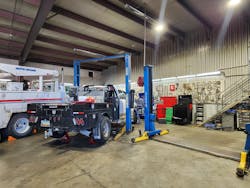Shop profile: Graber's Diesel Repair carries on a legacy
CHEYENNE, Wyoming—For Jon Graber, owner of Grabers Diesel Repair, turning wrenches isn’t so much a job as it is a calling, and one that he’s fostered since childhood.
“This is all I know,” said Graber, who drew his first shop logo at nine. “My entire life has been working toward building a truck repair shop.”
And Graber, 45, who now owns two locations in Cheyenne, has put in the work to make that dream a reality. But Graber’s dream has grown beyond shop ownership and into upholding a local trucking tradition that began in 1969. By doing so, he’s ensuring any truck with maintenance issues rolling through the intersection of Interstates 25 and 80 will get their needs met.
Starting out
Of course, the first and most critical part of Graber’s plan was to learn how to repair diesel trucks. The southeast Iowa native attended WyoTech, an automotive, diesel, and collision trade school in Laramie, Wyoming. He graduated in 2001, then headed about 50 miles west to Cheyenne. His first venture was modest—running a mobile repair business to service over-the-road vehicles.
Read more: Shop profile: Focus on technology and service drive growth at Dobbs“I took a camper trailer, gutted it, and made a mobile shop out of it,” Graber recalled.
But after about a year and a half, Graber outgrew the camper and bought his first service truck. A year later, Graber hired his first employee. Then he hired another technician and purchased a third truck. After that, he would soon need to come up with a more permanent blueprint for his childhood goal, as his wife “got completely annoyed with all the trucks,” he laughed.
To stay in his wife’s good graces, Graber rented out a single bay at an industrial lot east of Interstate 25 that he shared with several other businesses. As demand increased, Graber rented two more bays in the same location. In 2017, Graber made his biggest expansion yet.
Opportunity knocks
Things really kicked into high gear when Graber acquired Art’s Truck Terminal, a one-stop-shop smack dab at the intersection of I-25 and I-80, started in 1969 by Arthur Grout. It included a service center, restaurant, fuel station, convenience store, showers, and even some sleeping areas. The Grout family, who previously sold the truck stop, offered Graber the service portion in 2017. Graber readily accepted, bringing his total bay count up to five.
The most striking thing about it is the view. The building stands on the outskirts of town, overlooking I-25. Looking out of the service bay, you can see a sweeping view of the vast western sky and empty green fields.
For Graber, a self-professed history buff, it was a chance not only to expand his business but also to own a small piece of local trucking history. He said he was drawn to the story behind this scenic shop—and thinking about how many truckers have come through this location over the decades.
“We still get guys that come through that remember riding in the truck with their grandfather and stopping off at our truck terminal to get a service and dinner at the diner,” Graber said. “Call me sentimental, but I like the story behind something.”
Art retired in 1989 and passed the business on to his children, and the family legacy lives on even with Graber as the new owner. Art’s grandson, Daniel Ruiz, stayed on as lead technician.
“It was the only truck stop up on top of the hill here before Flying J moved in years later,” Ruiz recalled. Art hired his son (and Ruiz’ uncle) Cliff Grout, to run the service side when he returned from a tour of duty in Vietnam.
Meanwhile, Ruiz’s father, who married Cliff’s twin sister, served as the general manager of the truck stop portion. Ruiz worked on that side for a while too, until his uncle recruited him for the shop when he was 17.
“I was just one of those punk kids,” the 48-year-old Ruiz said. “He came up to me and said, ‘Hey, do you want to learn how to work for a living? I’ll show you how to do that.’”
Ruiz isn’t the only of Art’s progeny to stay on. His son, Joseph, also works in the shop.
“They grew up in the industry and are still here on the same property doing the same job,” Graber said.
Becoming a mentor
Maintenance is in the blood for Ruiz and his son, but Graber had to put more effort into training the shops’ 13 other techs, many of whom had no formal diesel education.
“I’ve got a fair amount of guys who actually never went to school, that either we trained from the ground up or started in another shop. And they learned and grew from there,” the shop owner said.
When these seedling techs start, it’s hard to predict how they will turn out. Graber has found that through mentorship, the investment can be quite fruitful. This was the case with Andrew Grantz, Graber’s longest-tenured employee. After assisting his dad with some work on their family vehicle, Grantz was hooked on vehicle repair and wanted to learn more. But he only had time to take one auto program class during his freshman year of high school before his family moved from Colorado Springs to Cheyenne. Luckily, Graber and Grantz crossed paths at church, where he agreed to let Grantz shadow at his shop.
After shadowing through high school, Grantz took diesel technology classes at Laramie Community College in Cheyenne while working for Graber a few hours each morning.
Read more: Apprentice program at Denver diesel shop a mile-high success“It wasn’t much,” Grantz said. “But it still allowed me to be in the shop and go to school, and then the next morning, I’d come in and see how my schoolwork might apply or not to whatever we’re actually doing in the shop.”
Once he graduated, Grantz returned to Grabers Diesel Repair full-time. But even with his schooling, the learning curve was steep.
“The transition period really hit me hard,” the 29-year-old related. “That first year was a huge struggle for me, and it’s only by Jon’s good graces and the grace of the Lord that I still have a job here.”
Grantz’s situation wasn’t helped by the physical demands of diesel work.
“I’ve always been smaller than most everybody,” said the 5’9, 140-lb. Grantz. “Coming into it, I’m working with guys that are bigger or stronger than I am.”
“He started green as ever,” Graber remembered. “He’s one of those kids where I even had a sit-down with him one day. He’s not big, and I was like, ‘I don’t know if this is the career for you.’”
But according to Graber, that single conversation changed everything for Grantz.
“It lit a fire under him,” Graber said. “And he started learning ways of overcoming his size, and he started working harder at it. As young as he is, he has become one of my best and longest-term employees.”
“That was a big turning point,” Grantz agreed. “I came in with a better attitude and the mindset of ‘let’s just take one job at a time, don’t be afraid to ask questions, and show them that I actually want to keep my job.’”
For Graber, this kind of individual attention is key to his leadership.
“When I can see that a guy’s growing and doing better, then I sit down and go, ‘Hey, you’re doing awesome. I’d like to see you start doing this or take on these responsibilities. I want to send you out to this training so you can learn more on this and become more proficient,’” Graber explained. “It’s an individual basis; that’s really how I’ve dealt with most of my guys.”
This approach helps Graber assign each of his nine technicians at the scenic site, and four at the original location, to the jobs that best suit their skills. With the help on hand at each location, Graber said he’s often able to process 25 walk-in invoices per day and 6 to 10 by appointment.
“We split it up with [the second location] being more for minor repairs, oil changes, wheel seals, and brakes—in-and-out jobs,” Graber noted. “Get them in, get them out as fast as possible.” Meanwhile, the first location handles larger jobs, such as engine work, diagnostics, and differentials.
Parts management
With each of the two shops handling different types of jobs, this makes inventory management critical, especially when the first shop may need more specialty parts, but the second also needs to be consistently stocked with day-to-day pieces.
“A large part of what we do is service or inventory,” Graber said. “It’s hard within our industry to know what to stock, so of the inventory I do stock, the parts are common to many vehicles. Over time, you learn what you do and don’t sell. So, stuff that’s not selling you get rid of; the stuff that you are selling, you bring more in or update newer filters and newer parts.”
To keep track of two sets of inventory, assignments, and techs, Graber uses Mitchell1’s ManagerEnterprise Pro, which allows him to manage invoicing, inventory, accounting and reports, and scheduling.
“It is an all-in-one suite, which is really nice,” Graber related. “It’s all web-based, so I can access it from a phone or laptop, no matter where I’m at any given time, and see what’s happening live, what jobs are being done, who’s clocked into what.”
This is especially helpful to Graber as he balances his managerial duties with his love for the craft. This is partially why Graber is most often stationed at the more scenic location, so that he can bring his diagnostic knowledge to bear while also managing the more active shop.
With Graber and his technicians almost constantly in motion between the bays, their inventory storage upstairs, and their work area, this sometimes means customers have to actively catch Graber when they arrive for a walk-in service. But while the small shop is busy, it pays off in personal attention to the drivers who use their services. The same technician who hears a complaint will likely be the one who fixes the truck, bills the customer, and sends them on their way.
From his workflow to his personalized approach to both customers and employees, Graber has ensured that he’ll carry on the Grout legacy for years to come and fulfill his childhood dream. Now, little gives him more pleasure than watching trucks return to Grabers Diesel Repair for the same reason they did 50 years ago.
“It’s amazing to see how you grow, and you get to that point where you’re moving work through,” Graber said. “It’s been fun.”
About the Author

Alex Keenan
Alex Keenan is an Associate Editor for Fleet Maintenance magazine. She has written on a variety of topics for the past several years and recently joined the transportation industry, reviewing content covering technician challenges and breaking industry news. She holds a bachelor's degree in English from Colorado State University in Fort Collins, Colorado.





